
The NewZealand Story is a platform game developed and released in arcades by Taito in 1988. The concept and setting were inspired by a holiday trip in New Zealand by one of the Taito programmers. The player controls Tiki (ティキ), a kiwi who must save his girlfriend Phee Phee (ピューピュー) and several of his other kiwi chick friends who have been kidnapped by a large blue leopard seal. While avoiding enemies, the player has to navigate a scrolling maze-like level, at the end of which they release one of Tiki's kiwi chick friends trapped in a cage. In 2007, the arcade game received a remake for the Nintendo DS under the title New Zealand Story Revolution.

Out Run is an arcade driving video game released by Sega in September 1986. It is known for its pioneering hardware and graphics, nonlinear gameplay, a selectable soundtrack with music composed by Hiroshi Kawaguchi, and the hydraulic motion simulator deluxe arcade cabinet. The goal is to avoid traffic and reach one of five destinations.
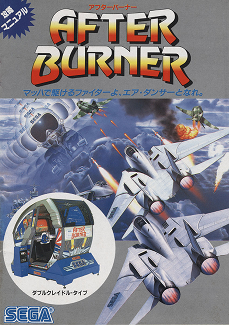
After Burner is a rail shooter arcade video game developed and released by Sega in 1987. The player controls an American F-14 Tomcat fighter jet and must clear each of the game's eighteen unique stages by destroying incoming enemies. The plane is equipped with a machine gun and a limited supply of heat-seeking missiles. The game uses a third-person perspective, as in Sega's earlier Space Harrier (1985) and Out Run (1986). It runs on the Sega X Board arcade system which is capable of surface and sprite rotation. It is the fourth Sega game to use a hydraulic "taikan" motion simulator arcade cabinet, one that is more elaborate than their earlier "taikan" simulator games. The cabinet simulates an aircraft cockpit, with flight stick controls, a chair with seatbelt, and hydraulic motion technology that moves, tilts, rolls and rotates the cockpit in sync with the on-screen action.

Chase H.Q. is a vehicular combat racing game, originally released as an arcade video game by Taito in 1988. It is sometimes seen as a spiritual successor to Taito's earlier Full Throttle. The player assumes the role of a police officer named Tony Gibson, member of the "Chase Special Investigation Department". Along with his partner, Raymond Broady, he must stop fleeing criminals in high-speed pursuits in a black Porsche 928.
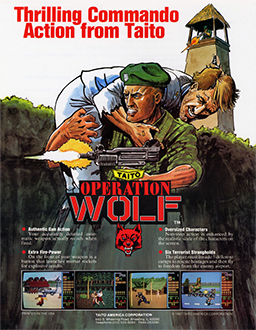
Operation Wolf is a light gun shooter arcade game developed by Taito and released in 1987. It was ported to many home systems.

Operation Thunderbolt is a light gun shooter video game developed by Taito and released for arcades in 1988. As the sequel to Operation Wolf, changes include two-player gameplay with two positional gun controllers mounted on the arcade cabinet, and a new forward-scrolling pseudo-3D perspective combined with side-scrolling sections.
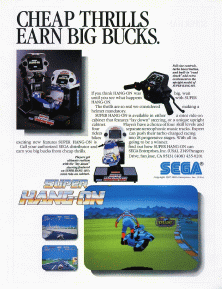
Super Hang-On is a motorcycle racing arcade video game released by Sega as the sequel to Hang-On. It uses a simulated motorcycle arcade cabinet, like the original game. An updated version was released in arcades 1991 as Limited Edition Hang-On.

Pit-Fighter is a fighting game developed by Atari Games and released as an arcade video game in 1990. It was Atari's first fighting game. The Japanese release was published by Konami. Home versions were published by Tengen.
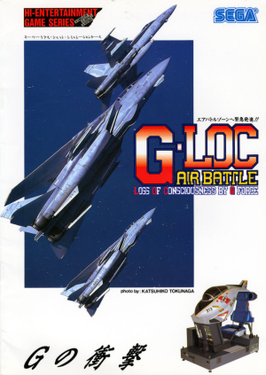
G-LOC: Air Battle is a 1990 combat flight simulator arcade video game developed and published by Sega. It is a spin-off of the company's After Burner series. The title refers to "G-force induced Loss Of Consciousness". The game is known for its use of the R360 motion simulator arcade cabinet. The arcade game was a commercial and critical success upon release.
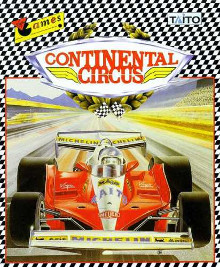
Continental Circus is a racing simulation arcade game, created and manufactured by Taito in 1987. In 1989, ports for the Amiga, Amstrad CPC, Atari ST, Commodore 64, MSX and ZX Spectrum were published by Virgin Games.

Special Criminal Investigation, also known as S.C.I. for short or as Chase HQ II: Special Criminal Investigation in some home versions, is vehicular combat racing game published by Taito for arcades in 1989. It is the sequel to the 1988 game Chase H.Q.
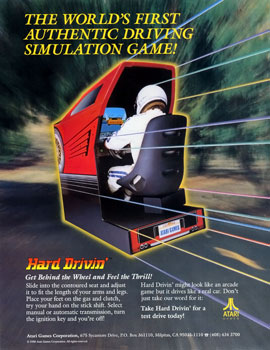
Hard Drivin' is a driving simulation video game developed by Atari Games in 1989. It invites players to test drive a sports car on courses that emphasize stunts and speed. The game features one of the first 3D polygon driving environments via a simulator cabinet with a force feedback steering wheel and a custom rendering architecture.
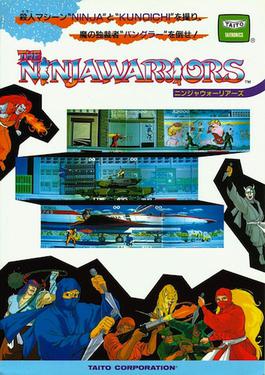
The Ninja Warriors (ニンジャウォーリアーズ) is a side-scrolling beat 'em up video game developed and released by Taito in 1987. The original arcade game situated one display in between projected images of two other displays, creating the appearance of a triple-wide screen. Ports were released for home systems including the Amiga, Atari ST, ZX Spectrum, Commodore 64, Amstrad CPC, PC Engine, and Sega Mega-CD.

GP Rider is a motorcycle racing game developed and manufactured by Sega, released in as an arcade video game in Japan, North America and Europe. It came in a two-player motion simulator cabinet and a standard upright cabinet. It was ported to the Master System in 1993 and then Game Gear in 1994.

Steel Talons is a 3D combat flight simulator arcade game released by Atari Games in 1991. The player takes on the role of a pilot for an "AT1196 Steel Talons combat helicopter". Steel Talons was ported to the Sega Genesis, Atari Lynx, Atari Falcon, and the Super Nintendo Entertainment System. A Jaguar port was announced, but never released.

Aliens is a 1990 run and gun video game developed and published for arcades by Konami. It is based on the 1986 film of the same title. Two players can play the game cooperatively in addition to single-player.

Space Gun is a 1990 first-person shooter arcade game released by Taito. The game is set aboard a crippled space station that has been overrun by hostile alien creatures. The objective is to rescue human crew members while destroying the alien creatures. The game lets the player shoot limbs off the creatures, resulting in blood splatters.

Racing Hero is a 1989 arcade racing game from Sega which runs on the Sega X Board hardware. In Racing Hero, the player takes part in an international race aboard a motorcycle and races against time and other vehicles. It draws much inspiration from Sega's successful Hang-On and Out Run series.

Gun Buster, also known as Gunbuster (ガンバスター) and released in North America as Operation Gunbuster, is a first-person shooter video game developed by Taito and released for arcades in 1992. In contrast to on-rail light gun shooters at the time, this was one of the first arcade games to feature free-roaming FPS gameplay, the same year Wolfenstein 3D was released on personal computers.
Landing is a series of flight simulator video games by Taito. Almost all games were released for arcades, except the Jet de Go! Series released for PlayStation consoles.



















